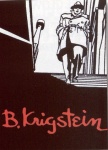
This week's New Yorker (dated July 22) contains Art Spiegelman's three-page essay about Greg Sadowski's biography of artist Bernard Krigstein (B. Krigstein, from Fantagraphics at $49.95). Spiegelman's essay is more about the conflict between high art and low art than it is about Sadowski's book, but who can blame Spiegelman for pointing out the most obvious and bitter paradox of Krigstein's career -- the fact that the artist will be remembered more for a handful of stories he illustrated for E.C. Comics than for his hundreds of paintings, which he produced during a long career as an artist and teacher at New York's High School of Art and Design. As Spiegelman points out in his opening paragraph, cartoonists have achieved considerable academic and critical interest today; but this current prestige and acceptance contrasts strongly with the 1950s, when the high art aesthetic articulated by Dwight McDonald reigned supreme. Given the intellectual climate during the period in which he matured, it's no wonder that Krigstein was reluctant to talk about his comic book work, even though Krigstein's comic book illustrations appear far more interesting to this generation than his paintings.


